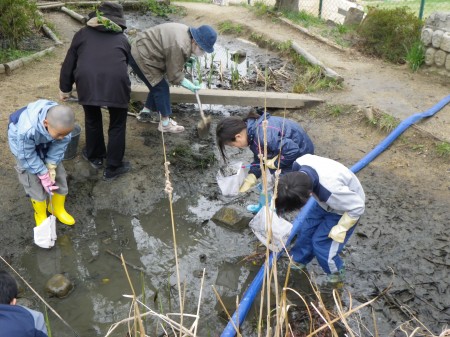feel conserve
A program initiated by residents of the river basin that integrates biodiversity conservation with education
Network for Conserving the River Basin in the Rain-Kissed Lands

“The integration of environmental conservation and education” – this is the key focus of the group. They help develop educational materials for elementary schools and also encourage the participation of children in conservation activities. These activities help children grow and some even go on to become leaders in conservation activities.

“The integration of environmental conservation and education” – this is the key focus of the group, Network for Conserving the River Basin in the Rain-Kissed Lands. This network is comprised of 4 organizations (Asuka River Jakotori Network, Minamikawachi Nature and Children’s Network, Taishi e Megane, Minamikawachi Hydrobiology Research Group). These organizations, which promote biodiversity recovery in the basin of the Ishikawa River that flows through the southeastern part of Osaka Prefecture, have joined hands to integrate environmental conservation with education.
They have developed an environmental education program that teaches children how we are all connected to nature and how living creatures are connected to one another by studying a freshwater fish only found in the Ishikawa River basin, the golden venus chub, classified by the Ministry of the Environment’s RDB as IB Endangered.
This environmental education program includes so-called experiential activities such as mowing grass in the sanctuary, which helps protect the biodiversity of the basin and observing and researching wildlife, as well as lectures that use picture-story shows and paper puppet theaters. So far, this program has taken place in 20 classrooms across 4 schools. The network also conducts wildlife observation workshops in the basin. Children and guardians whose interests were piqued through the environmental education program and wildlife observation workshops as well as people of the community are taking part in these conservation efforts. In 2012, over 300 people took part.
To help the basin’s biodiversity recover, the network is focusing on the protection and research study of the golden venus chub. As of now, they have created 8 sanctuaries that protect the golden venus chub as well as other wildlife in the basin.
Children take on a leading role at the sanctuaries (draining ponds dry to get rid of invasive alien species, mowing grass, etc.) and monitor the results with the support of the local community. Thanks to their efforts, the golden venus chub, killifish, and other fish species as well as aquatic insects such as dragonfly larvae and dark diving beetles have started to settle in these sanctuaries.
[ Click here to watch a video about their activities:http://youtu.be/NQJIJ_kGC38 ]
更新日:2013.11.03 ※記事の内容は投稿当時のものです









